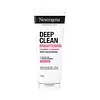Neutrogena Deep Clean Brightening Foaming Cleanser Versus Anua 8 Hyaluronic Acid Moisturizing Gentle Gel Cleanser
What's inside
What's inside
 Key Ingredients
Key Ingredients

 Benefits
Benefits

 Concerns
Concerns

No concerns
 Ingredients Side-by-side
Ingredients Side-by-side

Water
Skin ConditioningGlycerin
HumectantSodium Cocoyl Glycinate
CleansingSodium Cocoyl Isethionate
CleansingCocamidopropyl Betaine
CleansingMyristic Acid
CleansingGlycol Distearate
EmollientAcrylates Copolymer
Niacinamide
SmoothingLauric Acid
CleansingPEG-120 Methyl Glucose Dioleate
EmulsifyingPhenoxyethanol
PreservativeCaprylyl Glycol
EmollientParfum
MaskingChlorphenesin
AntimicrobialSodium Hydroxide
BufferingHydroxyethylcellulose
Emulsion StabilisingDisodium EDTA
Water, Glycerin, Sodium Cocoyl Glycinate, Sodium Cocoyl Isethionate, Cocamidopropyl Betaine, Myristic Acid, Glycol Distearate, Acrylates Copolymer, Niacinamide, Lauric Acid, PEG-120 Methyl Glucose Dioleate, Phenoxyethanol, Caprylyl Glycol, Parfum, Chlorphenesin, Sodium Hydroxide, Hydroxyethylcellulose, Disodium EDTA
Water
Skin ConditioningCoco-Betaine
CleansingSodium Cocoyl Alaninate
Potassium Cocoyl Glycinate
Acrylates Copolymer
Glycerin
Humectant1,2-Hexanediol
Skin ConditioningPropanediol
SolventPolyglyceryl-4 Caprate
EmulsifyingCaprylyl Glycol
EmollientHydroxyacetophenone
AntioxidantTromethamine
BufferingGlyceryl Glucoside
HumectantDisodium EDTA
Hydrolyzed Hyaluronic Acid
HumectantSqualane
EmollientEctoin
Skin ConditioningCitric Acid
BufferingHydrolyzed Vegetable Protein
Skin ConditioningMaltodextrin
AbsorbentHydrogenated Lecithin
EmulsifyingCeramide NP
Skin ConditioningButylene Glycol
HumectantHyaluronic Acid
HumectantHydrolyzed Sodium Hyaluronate
Skin ConditioningSodium Hyaluronate
HumectantPotassium Hyaluronate
Skin ConditioningHydroxypropyltrimonium Hyaluronate
Sodium Hyaluronate Crosspolymer
HumectantSodium Acetylated Hyaluronate
HumectantWater, Coco-Betaine, Sodium Cocoyl Alaninate, Potassium Cocoyl Glycinate, Acrylates Copolymer, Glycerin, 1,2-Hexanediol, Propanediol, Polyglyceryl-4 Caprate, Caprylyl Glycol, Hydroxyacetophenone, Tromethamine, Glyceryl Glucoside, Disodium EDTA, Hydrolyzed Hyaluronic Acid, Squalane, Ectoin, Citric Acid, Hydrolyzed Vegetable Protein, Maltodextrin, Hydrogenated Lecithin, Ceramide NP, Butylene Glycol, Hyaluronic Acid, Hydrolyzed Sodium Hyaluronate, Sodium Hyaluronate, Potassium Hyaluronate, Hydroxypropyltrimonium Hyaluronate, Sodium Hyaluronate Crosspolymer, Sodium Acetylated Hyaluronate
 Reviews
Reviews

Ingredients Explained
These ingredients are found in both products.
Ingredients higher up in an ingredient list are typically present in a larger amount.
Acrylates Copolymer is used as a film-forming agent and texture enhancer.
After applied, Acrylates Copolymer forms a thin film cover that helps skin feel more soft. It can help sunscreens become more water-resistant.
It is also used to make a product more thick.
Learn more about Acrylates CopolymerCaprylyl Glycol is a humectant and emollient, meaning it attracts and preserves moisture.
It is a common ingredient in many products, especially those designed to hydrate skin. The primary benefits are retaining moisture, skin softening, and promoting a healthy skin barrier.
Though Caprylyl Glycol is an alcohol derived from fatty acids, it is not the kind that can dry out skin.
This ingredient is also used as a preservative to extend the life of products. It has slight antimicrobial properties.
Learn more about Caprylyl GlycolDisodium EDTA plays a role in making products more stable by aiding other preservatives.
It is a chelating agent, meaning it neutralizes metal ions that may be found in a product.
Disodium EDTA is a salt of edetic acid and is found to be safe in cosmetic ingredients.
Learn more about Disodium EDTAGlycerin is already naturally found in your skin. It helps moisturize and protect your skin.
A study from 2016 found glycerin to be more effective as a humectant than AHAs and hyaluronic acid.
As a humectant, it helps the skin stay hydrated by pulling moisture to your skin. The low molecular weight of glycerin allows it to pull moisture into the deeper layers of your skin.
Hydrated skin improves your skin barrier; Your skin barrier helps protect against irritants and bacteria.
Glycerin has also been found to have antimicrobial and antiviral properties. Due to these properties, glycerin is often used in wound and burn treatments.
In cosmetics, glycerin is usually derived from plants such as soybean or palm. However, it can also be sourced from animals, such as tallow or animal fat.
This ingredient is organic, colorless, odorless, and non-toxic.
Glycerin is the name for this ingredient in American English. British English uses Glycerol/Glycerine.
Learn more about GlycerinWater. It's the most common cosmetic ingredient of all. You'll usually see it at the top of ingredient lists, meaning that it makes up the largest part of the product.
So why is it so popular? Water most often acts as a solvent - this means that it helps dissolve other ingredients into the formulation.
You'll also recognize water as that liquid we all need to stay alive. If you see this, drink a glass of water. Stay hydrated!
Learn more about Water